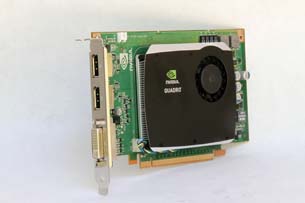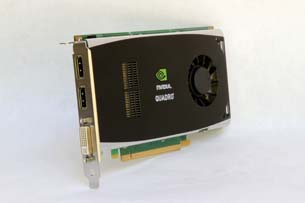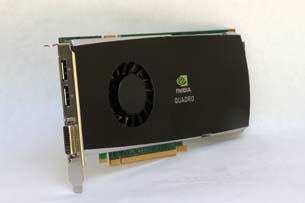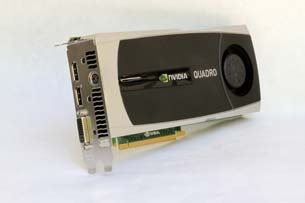NVIDIA Quadro Review
NVIDIA's latest collection of workstation graphics accelerators have CUDA support.
Latest News
December 4, 2001
By David Cohn
 The entry-level NVIDIA Quadro FX 580. |
It’s been two years since we last looked at the latest workstation-class graphics accelerators from NVIDIA—the Quadro FX series (see DE July 2008). Since then, the company has updated its entire lineup, including a trio of high-end boards based on the company’s new Fermi architecture. We’ve included one of these new boards, the NVIDIA Quadro 5000, in this roundup. Its new Quadro graphics processing unit (GPU) combines parallel processing with high-performance graphics functions.
According to NVIDIA, the new second generation GigaThread Engine in the 5000 allows up to 10x faster context switching operations over previous generation GPUs. The GigaThread Engine also provides dual Copy Engines, which allows simultaneous transfer of data into and out of the GPU in addition to either 3D processing or compute. Fermi is also the first GPU architecture to support ECC memory, which enables the graphics card to detect and correct some types of errors in hardware as data is accessed. The new Quadro architecture also incorporates a Scalable Geometry Engine that allows multiple graphics processor to create twice the number of raw polygons in a single clock cycle, and hardware tessellation for generating detailed geometry without sacrificing performance.
We also received three other boards: the FX 3800, FX 1800, and FX 580.
All four of the boards we tested use a PCI Express 2.0 x16 bus interface. The three older boards support DirectX 10 and Shader Model 4.0 while the new 5000 supports DirectX 11 and Shader Model 5.0. OpenGL support varies from 3.0 on the FX 580 and FX 1800, to 3.1 on the FX 3800 and version 4.0 on the new Quadro 5000. But all four of these NVIDIA graphics accelerators feature a full 30-bit display pipeline, as well as full-scene anti-aliasing, hardware 3D window clipping, and HDMI support via an HDMI adaptor.
 The mid-range NVIDIA Quadro FX 1800. |
NVIDIA was the first graphics card vendor to create a unified graphics architecture, in which processing power can be dynamically allocated to compute, geometry, shading, and pixel processing to optimize GPU performance. The entry-level FX 580 features 32 such processors while the GPU in the new Quadro 5000 provides 352 Compute Unified Device Architecture (CUDA) processors.
The new NVIDIA Quadro boards also include NVIDIA’s Application Configuration Engine (ACE), which automatically adjusts graphics settings for optimized application performance. All four boards also provide a single dual-link DVI-I output and a pair of DP connectors. Only two of the three digital outputs can be active at a time; the DVI port can also support a single analog monitor.
The latest boards also support the new NVIDIA CUDA GPU-computing software architecture. Some types of computing tasks have parts that are better suited for CPU computing while other parts are better suited for being run on the GPU. CUDA provides a standard C language interface so that programmers can synchronize hybrid programs running on both CPUs and GPUs.
The Quadro Family
At the entry level, the NVIDIA Quadro FX 580 provides 512MB of GDDR3 memory. The extra memory and more powerful GPU, with 32 NVIDIA CUDA processors yield double the bandwidth of the board it replaces. The FX 580 requires a single PCIe x16 slot and consumes 40 watts of power. While still available, the newest entry-level card from NVIDIA is the Quadro 600, which was just released in October.
 The high-end NVIDIA Quadro FX 3800. |
The mid-range is the sweet spot. The NVIDIA Quadro FX 1800 has doubled the number of GPU processors—from 32 in the older FX 1700 to 64 in the FX 1800—and a 192-bit memory interface. With 768MB of GDDR3 memory, the memory bandwidth triples to 38.4 GB/second, resulting in graphics performance anywhere from two to three times that of the older board. Yet the FX 1800 requires a single PCIe x16 slot and consumes just 59 watts. A newer cid-range card, the Quadro 2000, was recently released.
At the high end, NVIDIA replaced the FX 3700 with the Quadro FX 3800. This board comes with 1GB of GDDR3 memory—double that of the older board—while retaining the same 256-bit memory interface. This results in the same 51.2 GB/second memory bandwidth as the older board, but with 192 parallel processors—80 more than its predecessor—the NVIDIA FX 3800 easily outperforms the older board. This board also supports stereoscopic 3D output (with an optional 3-pin Mini-DIN bracket) as well as NVIDIA’s Scalable Link Interface (SLI). SLI technology enables users to leverage multiple NVIDIA Quadro FX graphics boards to dynamically scale graphics performance. The Quadro FX 3800 requires just a single PCIe X16 slot, but it consumes 108 watts and requires an auxiliary connection to the system power supply.
 The high-end NVIDIA Quadro 5000. |
The newest additions to the high end lineup are the Quadro 4000 and 5000. The5000 features 352 CUDA parallel processing cores and 2.5GB of GDDR5 memory to deliver up to eight times the performance of the previous generation Quadro FX 4800 when running computationally intensive applications such as ray tracing, video processing, and computational fluid dynamics. The 5000 provides two DP connections and a Dual-link DVI connector. It also supports stereoscopic 3D output, and has the 3-pin stereo connector built-in. The 5000 also supports NVIDIA’s SLI technology, and NVIDIA also offers an optional G-Sync card for frame lock and genlock. All of this power results in a bigger board consuming 152 watts, requiring an auxiliary power connection and the space of the adjacent expansion slot.
At the ultra high end is the new Quadro 6000, which will replace the FX 5800.
Benchmarking the Boards
While all of the new Quadro boards were not available for review in time for this roundup, we tested the three NVIDIA Quadro FX boards and the Quadro 5000 using the same HP xw6600 workstation equipped with a pair of 3GHz Quad-Core Xeon E5450 processors, so all of our results are directly comparable. Since NVIDIA updated its driver software for the newest boards, we also retested the previous generation of NVIDIA graphics cards using the updated driver, to get an accurate comparison of the performance improvements. This is the same system we recently used to test the latest ATI FirePro boards (see DE October 2010), so we can also compare the relative performance of boards from both manufacturers.
Pricing • NVIDIA Quadro FX 580: $170 (MSRP), $150 (average street) |
All tests were performed using both version 10 of the SPEC Viewperf benchmark and version 11, which was recently released, both at a resolution of 1280x1024.
Based on our own independent results, both the new generation Quadro 5000 board, along with the Quadro FX 3800, Quadro FX 1800, and Quadro FX 580 boards, do indeed surpass the performance of the older/previous FX generation boards. In fact, in most instances, the newer board at the lower price point beat the performance of the next step up from the previous generation.
With this new Quadro and newer Quadro FX boards, the competition between NVIDIA and AMD remains as fierce as ever, giving you, the user, lots of excellent choices at every price point.
More Info:
NVIDIA Corporation
Advanced Micro Devices, Inc. (AMD)
David Cohn is a computer consultant and technical writer based in Bellingham, WA, and has been benchmarking PCs since 1984. He’s a contributing editor to Desktop Engineering and the author of more than a dozen books. You can contact him via email at [email protected] or visit his website at dscohn.com.
Subscribe to our FREE magazine, FREE email newsletters or both!
Latest News
About the Author
David Cohn is a consultant and technical writer based in Bellingham, WA, and has been benchmarking PCs since 1984. He is a Contributing Editor to Digital Engineering, the former senior content manager at 4D Technologies, and the author of more than a dozen books. Email at [email protected] or visit his website at www.dscohn.com.
Follow DE





